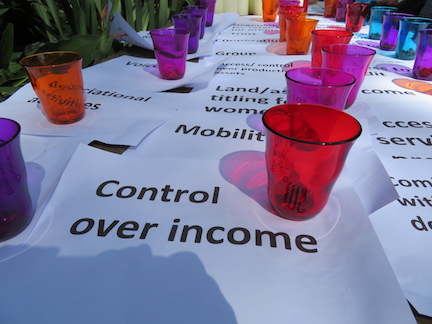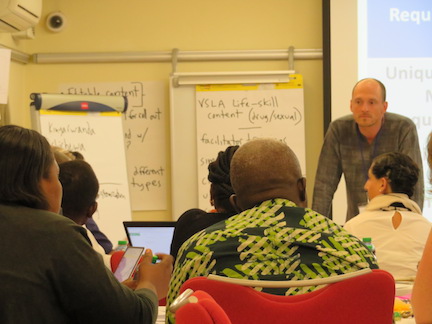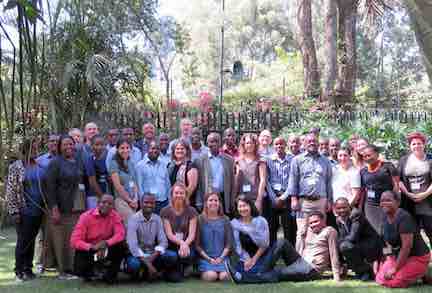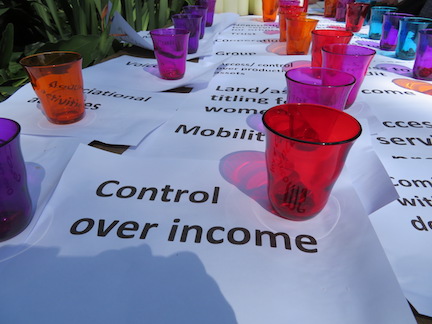Experiments in Collaboration
 Early this month, we invited nearly 50 people to join us in Nairobi for a two day “Co-Creation Workshop” in order to help us determine development and partnership priorities for our Self Help Group Digital Platform.
Early this month, we invited nearly 50 people to join us in Nairobi for a two day “Co-Creation Workshop” in order to help us determine development and partnership priorities for our Self Help Group Digital Platform.
This mobile app began as a simple directory of content, tailored to the cultural context and organizational needs of Tearfund in Ethiopia (who have great expertise with the program model). But we built for scale and our app is becoming a multi-lingual, content-rich digital platform capable of meeting the needs of a much wider partner ecosystem.
There are hundreds of millions of people around the world who participate in savings groups and self-help groups. And there are scores of organizations who devote time and money to founding and supporting these groups because of the transformational impact such groups have demonstrated in vulnerable communities.
There is a diverse and fast growing ecosystem of technologies being built for these groups, often focused on digital bookkeeping, mobile money transfers or enabling monitoring and evaluation protocols to provide transparency into group health and function.
We’re focused on providing a content-rich, field-tested volume of curricula specifically crafted for facilitators to use during group meetings, along with curricula that helps facilitators to develop their skills outside of the meeting context.
The organizations that joined us in Nairobi included large international organizations that are already household names, to smaller national NGOs that may be focused on spreading just a few hundred groups per year. A few donors, technologists and government organizations rounded out the field.

Different NGOs have different thematic priorities like improving conditions around water and sanitation, for example, or improving maternal and neonatal child health. They also run different varieties of group, for different durations and with different norms and expectations around interest and “pay-outs” or “graduation.” On top of that diversity, organizations operate in a variety of linguistic and cultural contexts.
When we received funding late last year, we made it clear that we’d need to gather together our potential partners in order to take direction from their needs and perspectives. That’s what this workshop was all about: bringing organizations together to look for areas of consensus that can determine where we invest and develop.
In advance of the workshop, there was trepidation among organizers and participants. After all, in other contexts, these organizations can emphasize their differences and their special ways of modifying the basic programmatic nugget: people saving small amounts of money together each week for their mutual benefit.
Although 90% of the people in the room focus many of their working hours on promoting and supporting self help or savings groups, when we asked people to raise their hands if they knew five or more people in the room, only a handful could do so.
We thought it would be helpful for these different organizations to learn about one another's (sometimes competing) priorities for (at least) two reasons: first, it will help our user community to understand that our development priorities are not set at random and that things which might not be immediately helpful within one organization’s context might be critical to another; second, we hoped to see priorities converge.
Our sessions focused on a few key areas:
* The front-end of the application—what you can see if you download the app from the play store (link)—which is what our facilitators and group members see;
* The back-end of the application—what you see if you have a password-protected coordinator login. Dashboards and panels that give you an indication of how your groups are functioning and what sort of data has been gathered from them.
* Different methods for monitoring and evaluating the groups, whether to validate the program model in general by surfacing increased resilience and prosperity, or whether to track aspects of the impact of our involving technologies in particular.
* What sort of thematic content is most urgent for these groups? What is most live-saving? What brings the greatest prosperity and health?
We assigned seating so that people from the same organizations and countries were rarely together and relied heavily upon table discussions to fill out worksheets that would then be presented to the larger group. We’re still chewing through roughly 150 pages of concrete and quality suggestions and perspective from the event.
And one of our favorite event innovations was to leave the last two and half hours relatively free on the second day, a Friday. We asked each organization to sit with one of our team members for 15 minutes at a pre-agreed time and provided a table of 15 minute time slots—all the rest of which were open. We encouraged participants, throughout the event, to make meetings with one another and to use those two and half hours to connect with one another.
But this was a Friday afternoon after the formal closing session of the event; so there was, understandably, some worry that people might pull a vanishing act. Instead, organizations sat together in all sorts of combinations even past the time we’d allotted for the meetings.
Having been at a ton of conferences that generate momentum and then end with some calls to collaborate afterwards, it felt great to move the “end” forward by a few hours and actually give that collaboration a chance to develop.
We’re grateful to all those who attended and to the Foundation support that it made it possible for us to hose this event. Stay tuned to hear what development priorities float to the top and which organizations join us soonest to continue improving upon this powerful open source tool for development.

